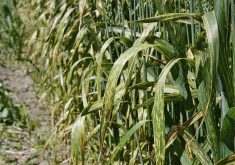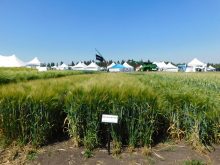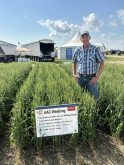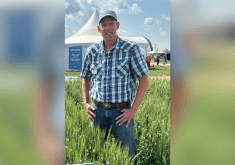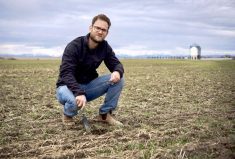Boosting nitrogen in barley, wide- versus narrow-row spacing, and three-way split nitrogen applications were in the spotlight in producer-driven on-farm trials in 2022.
Although increased yield wasn’t in the cards in several cases, moments of clarity may have made up for it.
Plot2Farm is a field-scale research program in which farmers themselves conduct the kind of on-farm trials they want with the assistance of Alberta Wheat and Barley staff, who ensure proper research protocols are employed.
Read Also

Hail research hopes to benefit potato growers
Alberta research scientist measures hail storm and heat dome affects on potato crops
“We provide a framework for farmers to implement on-farm research trials,” said Jeremy Boychyn, agronomy research and extension manager with the commissions.
“It gives producers a tool to make smarter or more sound decisions on which practices they’re implementing and which practices may be beneficial for them specifically on their farms, whether it be agronomically or logistically.”
[RELATED] Grainews: New cereal varieties for 2023
The trials also yield information others can use.
“For us as an industry, having these kind of trials being implemented on a broad scale can give us a snapshot of performance of how some of these practices may be impacting farm adoption.”
Last year, there were 13 Plot2Farm trials, including four on nitrogen-fixing foliar bacteria, none of which saw a yield boost.

This proved to be a running theme in several projects, including one that found too much nitrogen can hurt yields. That trial saw Lenz Farms near Bentley significantly increase rates on Sirish barley – to either 85 or 105 pounds per acre versus a baseline of 65 lb. Yields were actually 10 bushels per acre below baseline at the highest rate. The 85 lb.-per-acre treatment also saw some loss.
Lodging played a major role, said Boychyn.
“They’re interesting results, which highlight the value of making sure you’re not looking at agronomic considerations in a silo. Maybe a plant growth regulator would have added value and got more out of that increased N had that crop been standing.”
Two trials compared narrow (7.5 inch) versus wider (15 inch) row spacing in spring wheat. Newman Farms near Blackie grew CDC Go while Antler Valley Farms near Innisfail grew AAC Penhold. Both saw a yield drop of three per cent from the wider spacing, but Newman Farms saw a six per cent increase in protein.
The profit difference between the two spacings amounted to just over $25 per acre but Boychyn said the narrow-versus-wide debate cannot be ignored.
“This was the second year we did this trial,” he said. “Last year there was a four per cent reduction. I don’t want to call it a trend, but over the two years, there were some consistent results where there was a little bit of loss at the wider row spacing.”
Weighing those results is tricky. Planting wider rows saves fuel and wear on equipment, but it may also make weeds harder to control.
“A true assessment of economic viability between treatments would require long-term analysis,” the Plot2Farm report concluded.
A split nitrogen application trial also provided food for thought, and showed that the practice, as Boychyn puts it, “isn’t a silver bullet for increasing yield potential.”
Sage Creek Farms, near Three Hills, split its nitrogen application three ways on CDC Go: 57 per cent (80 lb. of nitrogen per acre) at seeding, 21 per cent (30 lb.) at the beginning of stem elongation and another 21 per cent at the end of booting stage. Yield results were then compared to the first treatment, in which all 140 lb. were applied at seeding.
Yields for both were about the same, although a half per cent increase in protein was seen under the split application. The results are consistent with those of several earlier small-plot trials.
But the bigger story is that the practice won’t likely present a threat to wheat yields, and that could be a big deal in a tough year.
“It verifies the idea that we aren’t losing yields when we do a split N app,” Boychyn said. “If producers are in a position where they’re unsure of the crop’s yield potential — say they’re in a drought condition early in the season and they don’t want to apply 100 per cent of their N — they could potentially apply 60 per cent or more (at seeding).
“If conditions improve and they get moisture, they can come in with a secondary application to top up to their typical 100 per cent. It can be used as a risk management tool.”
Farmers interested in participating in the next edition of Plot2Farm can either do a trial based on one of the protocols already created by Boychyn and his colleagues or email him at [email protected].
“Essentially they provide us with a treatment list and comparisons they want to make and we’ll work with the producer to compare those treatments,” he said.
The commissions are targeting 12 trials this year and the application deadline is at the end of February. For more info and the application form, go to albertawheatbarley.com/plot2farm.
“If you’re unsure how to approach the application, we’ll help you work through it,” Boychyn said. “The one caveat is we want to make sure we’re doing trials where there’s a broader value to farmers across Alberta or a large swath of Alberta.”




